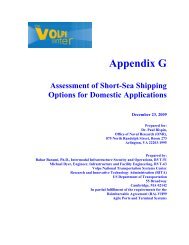ERRV Viking Islay - Marine Accident Investigation Branch
ERRV Viking Islay - Marine Accident Investigation Branch
ERRV Viking Islay - Marine Accident Investigation Branch
- No tags were found...
Create successful ePaper yourself
Turn your PDF publications into a flip-book with our unique Google optimized e-Paper software.
2.8.22.8.3Shipboard equipmentThe result of the company’s policy on entering dangerous enclosed/confined spaceswas that Vroon did not supply <strong>Viking</strong> <strong>Islay</strong> with the equipment required to make a safeentry to a dangerous enclosed/confined space. The ship was provided with a singlepersonal H 2 S alarm, but ship’s staff had no means of testing an enclosed/confinedcompartment’s atmosphere before entering it; neither did the ship carry the equipmentto force ventilate any compartment before entry if it proved necessary.Actions following the accidentFollowing the accident, Vroon issued a safety alert re-affirming the company’s policy ofusing shore based support for planned work in dangerous enclosed/confined spaces.The document also stated that a master should only consider initiating a dangerousenclosed/confined space entry at sea as a last resort, and only after he has exhaustedall other solutions. Therefore, it should be necessary to contemplate enteringdangerous enclosed/confined spaces only in extreme circumstances, and only oncea risk assessment, TRIC and PTW had been completed. If the ship did not have thecapability to do the job safely, then the job should not take place.However, as a result of the MCA’s inspection and subsequent detention of <strong>Viking</strong> <strong>Islay</strong>,Vroon has equipped her with the equipment necessary to effect safe entry to dangerousenclosed/confined spaces.2.92.9.1Hazard perception and risk acceptanceThe chain lockerA simple inspection, taking only a few minutes, would have shown that <strong>Viking</strong> <strong>Islay</strong>’schain locker was effectively a tank, made completely air tight by the application ofexpanding foam to seal the spurling pipes. Even without the expanding foam it was,without doubt, a potentially dangerous enclosed/confined space, and with the foam inplace its airtight integrity was assured. Therefore, as written, the Vroon SMS processfor entering a dangerous space should have been followed, and the chain locker onlyentered in port with specialists in attendance.Evidence suggests that on <strong>Viking</strong> <strong>Islay</strong> entry into the chain locker had, over timebeen undertaken to tie off the noisy anchor chain on many occasions. Nothing hasbeen found to indicate that either Mr Ebertowski or Mr O’Brien deliberately ignoredthe potential hazards of the chain locker, or that they agreed to take a calculated riskin conducting this task. Instead, it is perhaps because this task had evolved into afamiliar process that they did not recognise the potential risk Mr Ebertowski was takingwhen he entered the chain locker. It is clear that the locally produced sign, posted onthe aft bulkhead (Figure 6) had been of limited effect in informing the crew’s perceptionof the compartment and its hazards.Other crew members on <strong>Viking</strong> <strong>Islay</strong> were found to have mixed perceptions ofthe hazard posed by the chain locker, and of the risks faced when entering thatcompartment. Some were clear that the chain locker was a dangerous space; whilesome other crew members, including the master, were not aware that the chain lockerwas a dangerous enclosed/confined space. Some crew members had done similartasks in similar spaces (both on <strong>Viking</strong> <strong>Islay</strong> and other ships) and admitted that they31
















